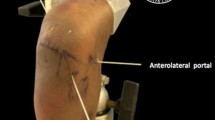Abstract
Purpose
To assess the effectiveness of cadaveric ankle arthroscopy courses in reducing iatrogenic injuries.
Methods
A total of 60 novice surgeons enrolled in a basic cadaveric ankle arthroscopy course were divided into two groups. Group A (n = 32) was lectured on portal placement and use of the arthroscope, whereas group B (n = 28) was in addition lectured on specific portal-related complications. Following the performance of anterior ankle arthroscopy and hindfoot endoscopy, the specimens were dissected and carefully assessed for detection of any iatrogenic injuries.
Results
The rate of injury to the superficial peroneal nerve (SPN) was reduced from 25 to 3.6%, in group A compared with B (p = 0.033). Injuries to the peroneus tertius or extensor digitorum longus, the flexor hallucis longus and the tibial nerve or the Achilles tendon were also reduced in group B. Overall, the number of uninjured specimens was 50% (n = 30) and higher in group B (57%) than group A (44%). Lesions to the plantaris tendon, the sural nerve or the posterior tibial artery were more common in group B, however, without reaching statistical significance. Overall, 25 (13.9%) anatomic structures were injured in anterior arthroscopy compared to 18 (5%) in hindfoot endoscopy, out of a potential total of 180 and 360, respectively (p = 0.001).
Conclusion
Dedicated lectures on portal-related complications have proven useful in reducing the risk of injury to the SPN, the commonest iatrogenic injury encountered in ankle arthroscopy. Hindfoot endoscopy is significantly safer than anterior ankle arthroscopy in terms of injury to anatomical structures.




Similar content being viewed by others
References
Bartlett JD, Lawrence JE, Khanduja V (2018) Virtual reality hip arthroscopy simulator demonstrates sufficient face validity. Knee Surg Sports Traumatol Arthrosc. https://doi.org/10.1007/s00167-018-5038-8
Butler A, Olson T, Koehler R, Nicandri G (2013) Do the skills acquired by novice surgeons using anatomic dry models transfer effectively to the task of diagnostic knee arthroscopy performed on cadaveric specimens? J Bone Jt Surg Am 95(3):e15(1–8)
Carro LP, Golanó P, Vega J (2007) Arthroscopic subtalar arthrodesis: the posterior approach in the prone position. Arthroscopy 23(4):445.e1–445.e4
Dalmau-Pastor M, Yasui Y, Calder JD, Karlsson J, Kerkhoffs GM, Kennedy JG (2016) Anatomy of the inferior extensor retinaculum and its role in lateral ankle ligament reconstruction: a pictorial essay. Knee Surg Sports Traumatol Arthrosc 24(4):957–962
Dalmau-Pastor M, Malagelada F, Kerkhoffs GMMJ, Manzanares MC, Vega J (2018) X-shaped inferior extensor retinaculum and its doubtful use in the Bröstrom-Gould procedure. Knee Surg Sports Traumatol Arthrosc 26(7):2171–2176
de Leeuw PA, Golanó P, Sierevelt IN, van Dijk CN (2010) The course of the superficial peroneal nerve in relation to the ankle position: anatomical study with ankle arthroscopic implications. Knee Surg Sports Traumatol Arthrosc 18(5):612–617
Epstein DM, Black BS, Sherman SL (2015) Anterior ankle arthroscopy: indications, pitfalls, and complications. Foot Ankle Clin 20(1):41–57
Frank RM, Wang KC, Davey A, Cotter EJ, Cole BJ, Romeo AA, Bush-Joseph CA, Bach BR Jr, Verma NN (2018) Utility of modern arthroscopic simulator training models: a meta-analysis and updated systematic review. Arthroscopy 34(5):1650–1677
Golanó P, Vega J, Pérez-Carro L, Götzens V (2006) Part I: the portals. Foot Ankle Clin 11(2):253–273
Golanó P, Vega J (2013) Comment on “Complications in ankle arthroscopy”: anatomy, an important factor to avoid complications related to ankle arthroscopy. Knee Surg Sports Traumatol Arthrosc 21(7):1708–1709
Lopes R, Andrieu M, Cordier G, Molinier F, Benoist J, Colin F, Thès A, Elkaïm M, Boniface O, Guillo S, Bauer T, French Arthroscopy Society (2018) Arthroscopic treatment of chronic ankle instability: prospective study of outcomes in 286 patients. Orthop Traumatol Surg Res 104(8S):S199–S205
Robinson L, Spanyer J, Yenna Z, Burchell P, Garber A, Riehl J (2017) Efficacy of arthroscopic teaching methods: a prospective randomized controlled study. J Surg Orthop Adv 26(3):154–159
Sprague NF III, Guhl JF, Olson DW (1989) Specific complications: elbow, wrist, hip, and ankle. In: Spraque NF 3rd (ed) Complications in arthroscopy, 1st edn. Raven Press, New York, pp 199–224
Ucerler H, Ikiz AA, Uygur M (2007) A cadaver study on preserving peroneal nerves during ankle arthroscopy. Foot Ankle Int 28:1172–1178
Vega J, Golanó P, Peña F (2016) Iatrogenic articular cartilage injuries during ankle arthroscopy. Knee Surg Sports Traumatol Arthrosc 24(4):1304–1310
Vega J, Dalmau-Pastor M, Malagelada F, Fargues-Polo B, Peña F (2017) Ankle arthroscopy: an update. J Bone Jt Surg Am 16(16):1395–1407 99(
Vega J, Redó D, Savín G, Malagelada F, Dalmau-Pastor M (2017) Anatomical variations of flexor hallucis longus tendon increase safety in hindfoot endoscopy. Knee Surg Sports Traumatol Arthrosc 25(6):1929–1935
Vega J, Dalmau-Pastor M (2018) Ankle arthroscopy: no-distraction and dorsiflexion technique is the key for ankle arthroscopy evolution. Arthroscopy 34(5):1380–1382
Zengerink M, van Dijk CN (2012) Complications in ankle arthroscopy. Knee Surg Sports Traumatol Arthrosc 20(8):1420–1431
Acknowledgements
The authors would like to thank GRECMIP for providing the cadaveric specimens used during its courses and giving permission to investigate them. We are grateful for its constant pursue of scientific knowledge that helps advance the research in minimally invasive foot and ankle techniques. Special thanks to Lynne Mackie and the Knowledge and Library Services at Barts Health NHS Trust for their assistance and continued support on the literature search and providing bibliography.
Funding
No external funding was used.
Author information
Authors and Affiliations
Corresponding author
Ethics declarations
Conflict of interest
The authors declare that they have no conflict of interest.
Ethical approval
All procedures were performed at the Dissection Room of the University of Bordeaux, and ethical approval was obtained with IRB Number: IRB00003099.
Additional information
Publisher's Note
Springer Nature remains neutral with regard to jurisdictional claims in published maps and institutional affiliations.
Rights and permissions
About this article
Cite this article
Malagelada, F., Vega, J., Guelfi, M. et al. Anatomic lectures on structures at risk prior to cadaveric courses reduce injury to the superficial peroneal nerve, the commonest complication in ankle arthroscopy. Knee Surg Sports Traumatol Arthrosc 28, 79–85 (2020). https://doi.org/10.1007/s00167-019-05373-x
Received:
Accepted:
Published:
Issue Date:
DOI: https://doi.org/10.1007/s00167-019-05373-x




